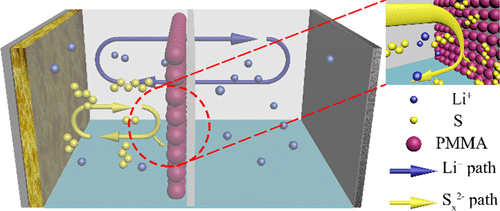当前位置:
X-MOL 学术
›
ACS Appl. Mater. Interfaces
›
论文详情
Our official English website, www.x-mol.net, welcomes your
feedback! (Note: you will need to create a separate account there.)
Double-Layered Modified Separators as Shuttle Suppressing Interlayers for Lithium–Sulfur Batteries
ACS Applied Materials & Interfaces ( IF 8.3 ) Pub Date : 2018-12-18 00:00:00 , DOI: 10.1021/acsami.8b14196 Chao Deng 1 , Zhuowen Wang 1 , Shengping Wang 1 , Jingxian Yu 2 , Darren J. Martin 3 , Ashok Kumar Nanjundan 3 , Yusuke Yamauchi 3, 4, 5
ACS Applied Materials & Interfaces ( IF 8.3 ) Pub Date : 2018-12-18 00:00:00 , DOI: 10.1021/acsami.8b14196 Chao Deng 1 , Zhuowen Wang 1 , Shengping Wang 1 , Jingxian Yu 2 , Darren J. Martin 3 , Ashok Kumar Nanjundan 3 , Yusuke Yamauchi 3, 4, 5
Affiliation

|
The shuttling phenomena in lithium–sulfur batteries lead to drastic attenuation of the capacity. This can be suppressed effectively by modifying the separator. Herein, a double-layered separator composed of a macroporous polypropylene (PP) matrix layer and an arrayed poly(methyl methacrylate) (PMMA) microsphere retarding layer is designed as the separator for lithium–sulfur batteries. A sulfur positive electrode with the PP/PMMA separator exhibits a high initial capacity of 1100.10 mAh g–1 at a current density of 0.1 mA cm–2 along with a high Coulombic efficiency, which is higher than the corresponding first discharge capacity results obtained using the standard PP separator (948.60 mAh g–1). In the double-layered separator, the arrayed PMMA microspheres can inhibit the diffusion of polysulfides through physical and chemical adsorption, thereby improving the electrochemical performance of lithium–sulfur batteries. In addition, the PMMA microspheres enhance the affinity of the separator to the electrolyte, which will increase the adsorption of the electrolyte to the separator and accelerate the diffusion rate of lithium ions.
中文翻译:

双层改性隔膜作为抑制锂硫电池穿梭的中间层
锂硫电池的穿梭现象会导致容量急剧下降。通过修改分隔符可以有效地抑制这种情况。在此,设计了一种由大孔聚丙烯(PP)基体层和阵列式聚甲基丙烯酸甲酯(PMMA)微球阻滞层组成的双层隔板,作为锂硫电池的隔板。带有PP / PMMA隔膜的硫正电极在0.1 mA cm -2的电流密度下具有1100.10 mAh g –1的高初始容量以及高库仑效率,这高于使用该方法获得的相应首次放电容量结果标准PP隔板(948.60 mAh g –1)。在双层隔膜中,排列的PMMA微球可以通过物理和化学吸附抑制多硫化物的扩散,从而改善锂硫电池的电化学性能。另外,PMMA微球增强了隔板对电解质的亲和力,这将增加电解质对隔板的吸附并加速锂离子的扩散速率。
更新日期:2018-12-18
中文翻译:

双层改性隔膜作为抑制锂硫电池穿梭的中间层
锂硫电池的穿梭现象会导致容量急剧下降。通过修改分隔符可以有效地抑制这种情况。在此,设计了一种由大孔聚丙烯(PP)基体层和阵列式聚甲基丙烯酸甲酯(PMMA)微球阻滞层组成的双层隔板,作为锂硫电池的隔板。带有PP / PMMA隔膜的硫正电极在0.1 mA cm -2的电流密度下具有1100.10 mAh g –1的高初始容量以及高库仑效率,这高于使用该方法获得的相应首次放电容量结果标准PP隔板(948.60 mAh g –1)。在双层隔膜中,排列的PMMA微球可以通过物理和化学吸附抑制多硫化物的扩散,从而改善锂硫电池的电化学性能。另外,PMMA微球增强了隔板对电解质的亲和力,这将增加电解质对隔板的吸附并加速锂离子的扩散速率。















































 京公网安备 11010802027423号
京公网安备 11010802027423号